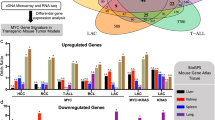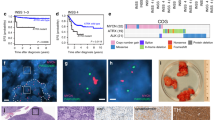Abstract
Proto-oncogenes represent a group of eukaryotic genes whose activated forms are implicated in the development of cancer (for reviews, see refs 1–3). We have recently identified a human gene, N-myc, that is distantly related to the proto-oncogene c-myc4. N-myc is expressed at abnormally high levels consequent to amplification in numerous human neuroblastoma cell lines and metastatic neuroblastoma tumours5,6. In addition, enhanced expression of N-myc, often a result of amplification, has been found in retinoblastoma cell lines and tumours (refs 5,7 and M.S., unpublished data) and in cell lines derived from small-cell carcinomas of the lung8. Here, we show that enhanced expression of N-myc subsequent to co-transfections of an N-myc expression vector and the mutant c-Ha-ras-1(EJ) (from the human bladder carcinoma cell line EJ) is a factor in tumorigenic conversion of secondary rat embryo cells. The transformed cells elicit tumours in athymic mice and isogeneic rats. The ability of N-myc to contribute to neoplastic transformation of cultured mammalian cells raises the possibility that enhanced expression consequent to amplification of N-myc may be a factor in the aetiology of human neuroblastoma.
This is a preview of subscription content, access via your institution
Access options
Subscribe to this journal
Receive 51 print issues and online access
$199.00 per year
only $3.90 per issue
Buy this article
- Purchase on Springer Link
- Instant access to full article PDF
Prices may be subject to local taxes which are calculated during checkout
Similar content being viewed by others
References
Bishop, J. M. J. Rev. Biochem. 52, 301–354 (1983).
Varmus, H. E. A Rev. Genet. 18, 553–612 (1984).
Schwab, M. Adv. Cancer Res. 46 (in the press).
Schwab, M. et al. Nature 305, 245–248 (1983).
Schwab, M. et al. Proc. natn. Acad. Sci. U.S.A. 81, 4940–4944 (1984).
Brodeur, G., Seeger, R., Schwab, M., Varmu, H. E. & Bishop, J. M. Science 224, 1121–1124 (1984).
Lee, W. H., Murphee, A. L. & Benedict, W. F. Nature 309, 458–460 (1984).
Nau, M. M. et al. Curr. Topics Microbiol. Immun. 113, 172–177 (year?).
Graham, F. L. & van der Eb, A. J. Virology 512, 456–461 (1973).
Land, H., Parada, L. & Weinberg, R. A. Nature 304, 596–602 (1983).
Shih, C. & Weinberg, R. A. Cell 29, 161–169 (1982).
Kohl, N. et al. Cell 35, 359–367 (1983).
Ralston, R. & Bishop, J. M. Nature 306, 803–806 (1983).
Ruley, H. E. Nature 304, 602–606 (1983).
Eliyahu, D., Raz, A., Gruss, P., Givol, D. & Oren, M. Nature 312, 646–649 (1984).
Parada, L., Land, H., Weinberg, R., Wolf, D. & Rotter, V. Nature 312, 649–651 (1984).
Jenkins, J. R., Rudge, K. & Currie, G. Nature 312, 651–654 (1984).
Becker, L. E. & Hinton, D. Hum. Path. 14, 538–550 (1983).
Ellis, R. et al. J. Virol. 36, 408–420 (1980).
Author information
Authors and Affiliations
Rights and permissions
About this article
Cite this article
Schwab, M., Varmus, H. & Bishop, J. Human N-myc gene contributes to neoplastic transformation of mammalian cells in culture. Nature 316, 160–162 (1985). https://doi.org/10.1038/316160a0
Received:
Accepted:
Issue Date:
DOI: https://doi.org/10.1038/316160a0
This article is cited by
-
Droplet digital PCR as an alternative to FISH for MYCN amplification detection in human neuroblastoma FFPE samples
BMC Cancer (2019)
-
The HDAC6 inhibitor C1A modulates autophagy substrates in diverse cancer cells and induces cell death
British Journal of Cancer (2018)
-
BPTF is required for c-MYC transcriptional activity and in vivo tumorigenesis
Nature Communications (2016)
-
Neuroblastoma
Nature Reviews Disease Primers (2016)
-
Neuroblastoma: oncogenic mechanisms and therapeutic exploitation of necroptosis
Cell Death & Disease (2015)
Comments
By submitting a comment you agree to abide by our Terms and Community Guidelines. If you find something abusive or that does not comply with our terms or guidelines please flag it as inappropriate.



